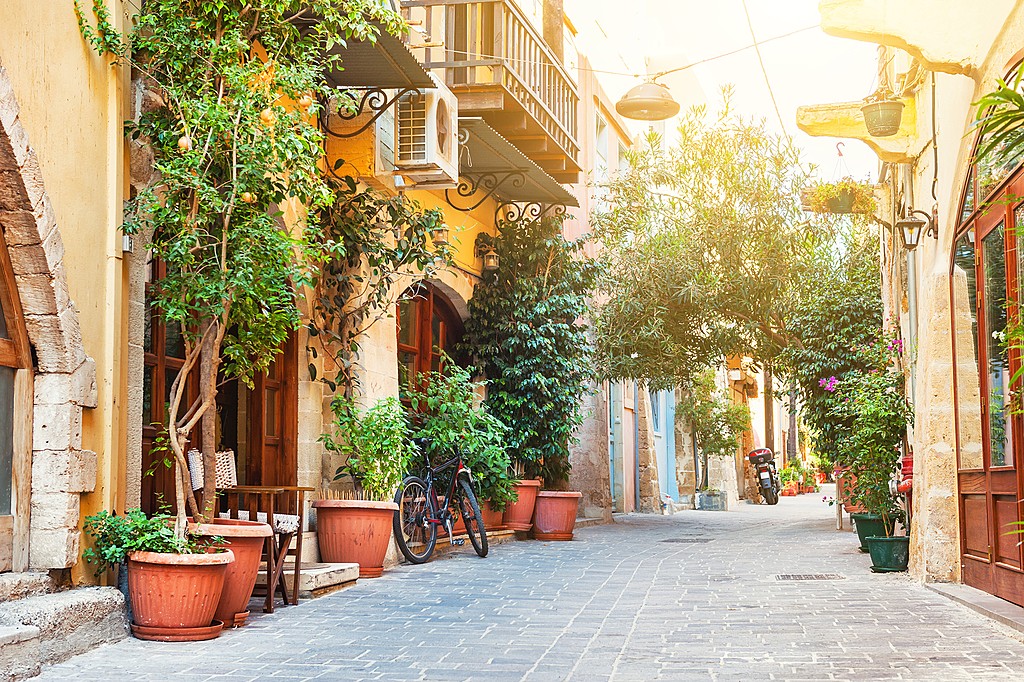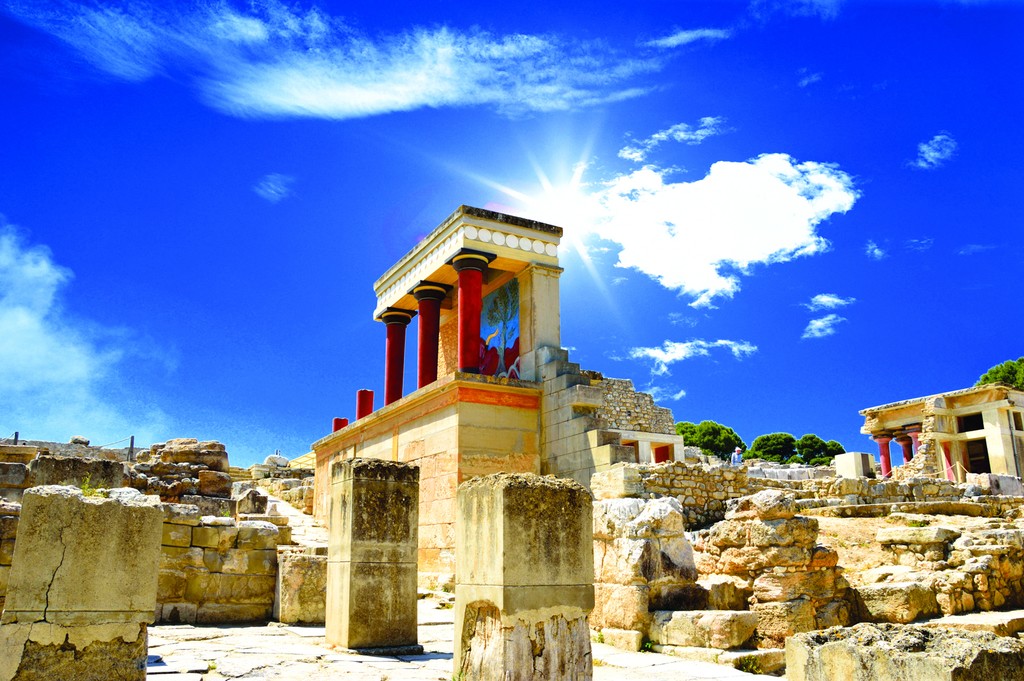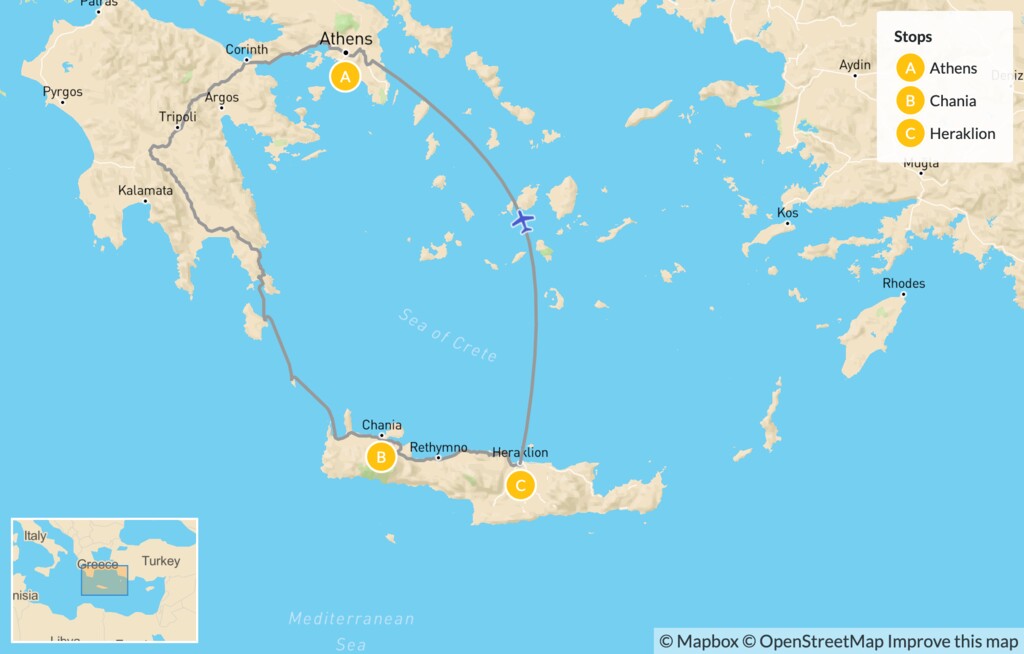Highlights
- Find an artistic perspective on the Parthenon
- Exercise at the home of the first modern Olympics
- Search for treasures in the Natural Park of Samaria
- Learn to make bread and rusks the Cretan way
Brief Itinerary
| Day | Highlights | Overnight |
|---|---|---|
| Day 1 | Arrive in Athens & Explore the Plaka Neighborhood | Athens |
| Day 2 | Painting the Parthenon & Family Mythology Tour | Athens |
| Day 3 | Olympic Games Workout & Athenian Riviera Tour for Families | Athens |
| Day 4 | Athens to Chania | Chania |
| Day 5 | Elafonissi Beach & Afternoon Workshop | Chania |
| Day 6 | Treasure Hunt in the Botanical Garden | Chania |
| Day 7 | Chania to Heraklion & Cultural Tour of Rethymno Town | Heraklion |
| Day 8 | Traditional Rusk & Bread-Making Workshop | Heraklion |
| Day 9 | Minoan Myths Around Knossos | Heraklion |
| Day 10 | Heraklion to Athens & Depart |
Detailed Itinerary
Day 1: Arrive in Athens & Explore the Plaka Neighborhood

Welcome to Greece!
Once you've settled in at your lodgings, head out into Athens for a walk through the Plaka neighborhood, the oldest and the most charming neighborhood of the city and ideal for an evening stroll.
Walk in the pedestrian part of the city and try to trace the remnants of the city’s various stages at spots like the Roman Agora, the Old University, the Tower & the Bath House of the Winds, the Benizelos Mansion, the Monument of Lysicrates, and all the lovely Byzantine churches. If you have the time, stop in at one of the two children’s museums, the Museum of Greek Children’s Art and the School Life & Education Museum.
Settle in at a taverna for dinner or pick up souvlaki along Monastiraki Square, then finish it off with some loukoumades, traditional fried dough with honey and cinnamon.
Day 2: Painting the Parthenon & Family Mythology Tour

Practice your artistic skills while learning about ancient Athens by painting the Parthenon, the symbol of ancient Greece. A family-friendly and local professional painter will take you to Pnyx Hill, a scenic spot with a clear view of this world-renowned monument.
Before painting, you'll learn about the site's history. Ancient Greeks built the Parthenon between 447-432 BCE as a dedication to the goddess Athena, the protector of Athens. A feat of Greek architecture, the marble temple contains no straight lines or angles anywhere among its 46 outer and 19 inner tapered Doric columns.
To sharpen your skills, you'll enjoy a short workshop on drawing and painting techniques. Learn about color combinations, perspective, and capturing the unique architectural components of the Parthenon.
Now that your creative juices are flowing, explore the Acropolis and Ancient Agora with your family, learning about Greek mythology and history while enjoying views of the city and kid-friendly activities.
After meeting your guide, you'll start your walk up to Acropolis Hill, the "Sacred Rock" that defines Athens. You'll visit all its popular monuments, including the Parthenon, Theater of Dionysus, Temple of Athena Nike, and Temple of Erechtheion. Listen to the legends of the Greek pantheon, such as the mighty Zeus, Athena (goddess of wisdom), Poseidon (god of the sea), Dionysus (god of wine and theater), and more. The stories will keep kids entertained and asking questions.
After enjoying Acropolis Hill and learning the city's secrets, you'll walk down to the ancient marketplace, the Agora. Socrates and Plato hosted many political and philosophical discussions on this plaza. At the end of the tour, enjoy a family activity inside the ancient Agora, using all your newfound knowledge about Greek gods, goddesses, and heroes.
Day 3: Olympic Games Workout & Athenian Riviera Tour for Families

Get your blood pumping and try your luck as an Olympian at the very venue where the first modern Olympics took place in 1896. You’ll start your day at the Zappeion, a neoclassical building set just below the National Garden. Here, you’ll meet your trainer and learn how the ancient Olympics impacted society for over a millennium.
The year 1896 marked the revival of the ancient Olympic Games, which occurred every four years starting in 776 BCE. You’ll stand in the very spot where the athletes stood and learn how they trained, what the games entailed, and how the competition evolved.
After learning about the games, you'll start your workout in a historic gym. Your trainer will teach you some classic techniques from the original Olympic events, including the discus and the javelin throw. You'll also practice more modern sports, such as the shot put, long jump, and relay race.
All of your training will prepare you for your own competition—a race in the Panathenaic Stadium! This stadium is the only one in the world made entirely of marble. Following the hallowed track, you'll race around the arena before receiving your official certificate of participation.
Next up, a private car will whisk you along the Athenian Riviera, a beautiful coastline with hidden bays and beaches. You will pass the Stavros Niarchos Cultural Center and Park and then by the Flisvos Marina with its family-friendly restaurants and coffee shops.
You can make an optional stop here to visit the Neraida Floating Museum, which narrates the business career of the ship’s owner, John Latsis, as well as the history of the ship from its construction in 1939 to the completion of its reconstruction in 2010. If you and your kids love ships and boats, and especially battleships, do not miss the opportunity to visit the Park of Naval Tradition inside the marina. Historic vessels are docked there, such as the destroyer “Velos” (now a museum of the struggle against the military dictatorship), the only copy of an ancient trireme named “Olympias” and the cable-laying ship “Thales of Miletus’ constructed in the U.S. in 1909.
Further south, another optional stop is at the rescue and rehabilitation center for sea turtles, run by the Sea Turtle Protection Society of Greece in Glyfada. Its purpose is to treat injured and sick sea turtles and eventually release them back into the sea, as well as to raise awareness regarding this rare species that reproduces in the sandy beaches of the Mediterranean Sea. Take part in the sea turtle rescue tours, adopt a sea turtle for 10 days, and enjoy a meal on the Glyfada beach.
The tour ends at the tip of Cape Sounion, home to the famous Temple of Poseidon that overlooks the Saronic Gulf and its islands. Before heading back to the city, you can opt for an early dinner at a traditional taverna right on the beach. Enjoy fresh seafood caught just a few feet from where you're sitting, plus good company and the sound of the waves lapping the shore as you watch the sunset.
Day 4: Athens to Chania

Take an overnight ferry ride from Athens to Chania. You'll board the ship in the evening, settle in to your cabin, and disembark on Crete the following morning.
Chania is one of Crete's highlights, with its charming 14th-century harbor and colorful architecture influenced by Venetian, Ottoman, and Egyptian eras. Discover the beauty of the city with a free evening to explore its picturesque streets and historical monuments.
Start at the Municipal Market of Chania, where you can try some of the local products. Then stroll through the Municipal Gardens and make your way into the center of the old town. Here you'll enjoy a first glimpse of the city's preserved streets and characteristic buildings that make it so special.
Continue toward the old port and enjoy the breeze off the Aegean Sea. Chania's famed Venetian harbor features impressive seafront residences and buildings (some working as boutique hotels), an old mosque, and a lighthouse. Find your favorite spot to take a break and relax with a refreshing drink before exploring Chania's off-the-beaten-path neighborhoods.
The districts of Topanas, Splantzia, Kolombo, and Kasteli all offer panoramic views of the harbor, traditional Cretan taverns, and grand buildings. If you prefer to ditch any crowds, wander a bit further into the Halepa and Tabakaria neighborhoods. Here you'll discover more authentic Cretan communities and seafront tavernas for dinner.
For incredible views away from the city, head to the Venizelos Tombs atop Prophet Ilias Hill. Here you'll find the Venizelos family's graves, including that of Eleftherios Venizelos, a respected politician and former Prime Minister of Greece. This historic spot sits above Chania, offering a peaceful setting and sprawling scenery out into the sea.
After enjoying a traditional dinner at one of the city's many cafes, restaurants, and taverns, end your day with a sunset drink at one of the old port's rooftop bars.
Chat with a local specialist who can help organize your trip.
Day 5: Elafonissi Beach & Afternoon Workshop

Experience the beauty of one of Greece's most popular and famous beaches, Elafonissi. Savor the crystal-clear turquoise waters, shallow and warm swimming areas, and the pink-hued sand that hugs the shore. Together, the natural elements create unmatched scenery on this small island. Relax on the beach, swim in the warm waters, snorkel through the shallow parts, and savor the gorgeous natural surroundings.
On your way back to Chania, you'll make one final stop in the village of Elos, where you'll enjoy Cretan dishes at a traditional tavern. In the afternoon, enjoy a family-friendly workshop. You have two choices: an excavation simulation that's popular with younger children, or a mosaic workshop for older kids and teens.
During the excavation experience, your family will receive an introduction to archeology from a real archeologist: what is it, what do archaeologists do, and how do they tackle an excavation? Then, you'll conduct a dig in a Minoan house. Using a combination of Minoan artifacts and fossils buried in the sand, you and your family will reconstruct history.
In the mosaic workshop, you'll learn about mosaic art's fascinating history, which originated from the Minoan Cretans. Choose your favorite photos, cut the stones, and create your very own mosaic. Take your souvenir home to remind you of your time as an archaeologist and Minoan artist.
Day 6: Treasure Hunt in the Botanical Garden

Learn why scientists describe Crete as "the minuscule continent" with a treasure hunt at the Botanical Gardens. Because the island shares the environment of three continents (Africa, Asia, and Europe), it offers an impressively diverse fauna and flora. Crete contains some of the most impressive examples of this historical and geological "sharing."
On this family treasure hunt, you'll explore all three continents in this beautifully green setting set on the outskirts of the renowned Natural Park of Samaria. Encounter peacocks, hunt for banana trees, and try to spy the rarest flowers in the garden. After the tour and the game, you'll enjoy traditional cuisine at the garden’s terrace overlooking the northern coast.
Day 7: Chania to Heraklion & Cultural Tour of Rethymno Town

Take a scenic drive of roughly two hours from Chania to Heraklion. Enjoy views of the coastline and Cretan countryside along the way, filled with olive groves and mountain views to the south.
Just a couple of miles off the main road, you'll find the scenic turquoise Lake Kournas. Stop here to stretch your legs and walk around the lake, or rent kayaks or paddleboats. If time allows, continue further south to the traditional village of Argyroupoli, where you can enjoy an authentic Greek meal next to the area’s waterfalls.
Don't miss the seaside town of Rethymno, where you can leave your car and wander the streets of Old Town, one of the best-preserved medieval cities in Greece. Take some time to stroll around its narrow streets, colorfully decorated with flowers, and discover the unique culture of this charming city.
The first thing to notice is how the city's Venetian fortifications mingle harmoniously with contrasting religious structures. You'll find Orthodox and Catholic churches standing near mosques and mansions sporting Venetian architecture, all blending together. In the small Venetian harbor, admire the 13th-century Venetian mole that once protected the city from the wild Cretan Sea. At the end stands the imposing lighthouse, built by the Turks after the 17th century.
Next, walk up to the Venetian Fortezza, an impressive Venetian fortress built in 1573 CE to protect the city. Here you'll find the remains of buildings and churches, plus incredible views of the city and the sea. Move on to the Archaeological Museum and enjoy exhibits from Neolithic to Roman times. You can also view Archaic and early Christian artifacts from Eleftherna or Minoan items from the Armeni and Monastiraki sites.
For something a bit lighter, pop into the Folklore and History Museum. Housed in a restored Venetian building with a beautiful courtyard, the gallery offers eight halls with over 5,000 items dating from the 17th to the 20th centuries. Peruse collections of textiles, woven baskets, embroidery, lace, historical costumes, ceramics, photographs, maps, weapons, coins, and more.
Day 8: Traditional Rusk & Bread-Making Workshop

Learn about Greece's ritual of breadmaking and try your hand at creating your own loaf today. This family workshop combines the tradition of bread with the modern lifestyle as you learn about the historical importance of this daily food staple from the Stone Age to the present day.
You'll start by learning about different grains and cereals. Then, get acquainted with sourdough and practice kneading your own bread and rusk, a traditional Cretan biscuit. While your bread is rising and baking, you'll taste some of the local Cretan cuisines. Discover the important flavors and ingredients that popularized this diet around the world. Your host will share the best of Crete's favorite delicacies before you enjoy your warm bread fresh from the oven.
Day 9: Minoan Myths Around Knossos

Discover the ancient scenery and myths of Minos, Ariadne, Theseus, the Minotaur, and the Labyrinth on this family-friendly adventure. This unique educational activity explores the roots of the Minoan civilization with some of the most popular Greek stories and myths and will prepare your family for a visit to the archaeological site at the Palace of Knossos.
The day's activities were inspired by the great writer and philosopher Nikos Kazantzakis. His book, "At the Palaces of Knossos," dives into the ancient Minoan civilization. With the help of interactive games and activities designed by experienced educators, your family will travel back in time 4,000 years to one of the most interesting periods of time: Minoan Crete.
You'll enjoy a picnic lunch similar to the traditional Minoan diet. If you so choose, you can also add on a visit to the Palace of Knossos archaeological site itself, where an experienced interpretive guide will help you explore the archeological site and put your new knowledge to the test.
Day 10: Heraklion to Athens & Depart



